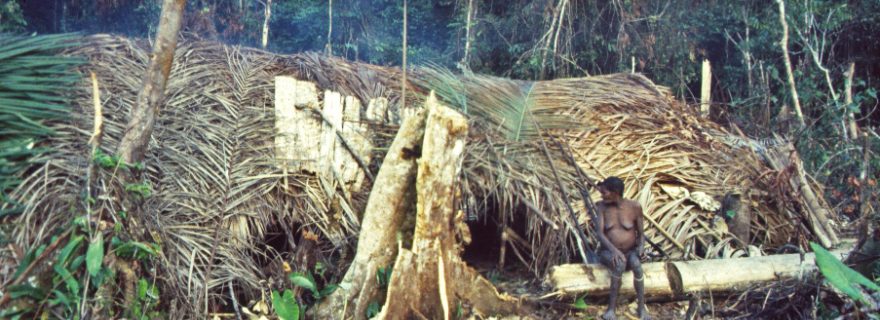Self-isolation as a Choice: The Sentinelese and the Missionary
In November, the killing of a missionary on North-Sentinel attracted a lot of media attention. The fact that John Chau tried to set foot on an officially closed area generated some blunt reactions. But what does the future of isolated tribes look like?
After the event hit the news, several staff members of our Institute were approached by the media (radio programmes, newspapers and news websites) to comment on the tragedy. Questions they received focused in the first place on the tribe itself: What do we know about them? How isolated are they? Why do they resist contact? With how many are they? Additional questions focused on knowledge about similar tribes in other parts of the world, and on moral judgments about what “we” should do with peoples who want to be left alone. Many of these questions are not easy to answer, because we simply lack firsthand knowledge about the people living on North Sentinel. As far as we know, no research has been done among them for many years and the Indian government has forbidden any outsider to step on the island for whatever purpose.
Further back in history there have been contacts, just as with some other ethnic groups in the Andaman and Nicobar islands. However, these contacts, some of which date back to the British colonial times, have had dramatic effects on the islanders in terms of violent clashes and the introduction of new diseases. Population numbers of most of the indigenous groups declined steadily. Some of them even went extinct. And those who did not, like the Sentinelese, opted for self-isolation. The dramatic history of the indigenous peoples of the Andaman and Nicobar islands has forced the Indian government to close off some of the areas. The people living in these areas, including the Sentinelese, are counted among the country’s Particularly Vulnerable Tribal Groups.
‘Uncontacted tribes’
The policy of controlled isolation is not new in the world of indigenous peoples. In fact, it goes back quite a number of years. Events in Brazil at the end of the 1960s, including the killing of invaders by a group of Xingu Indians, gave rise to this policy to protect ‘The tribe that hides from man’ (book and film by Adrian Cowell). A few decades later, in 2008, the widely published ‘discovery’ of a new tribe in the Brazilian Amazon generated heated debates among advocates of rights of indigenous peoples, governmental agencies and scientists.
Survival International, a London based NGO, published a short report and DVD, called ‘Uncontacted tribes’. It estimated that there were about 100 of such tribes, most of them in Latin America but some in Asia and Papua New Guinea. Brazil and Peru, just like India, had then already adopted such a policy to ‘leave them alone’. In 2012 the High Commissioner for Human Rights of the United Nations issued special guidelines for the protection of isolated peoples in addition to the UN Declaration on the Rights of Indigenous Peoples of 2007.
Vanished tribe?
Notwithstanding this institutional support, the policy of controlled isolation has also been criticized for never being implemented effectively over a longer period of time. In 2015, two anthropologists, Robert Walker and Kim Hill, argued in the journal Science that this kind of policy does not offer enough protection against the external threats of invading miners, loggers, drug smugglers and hunters. By definition, uncontacted peoples live in distant areas and the field staff charged with their protection rarely avails of enough manpower and equipment to keep out uninvited strangers. The recent history of many uncontacted tribes in Brazil, Peru, and Ecuador makes this dramatically clear.
The governmental agency FUNAI (National Indian Foundation) in Brazil, for instance, has had to acknowledge its inability to protect a number of such tribes. In 2011 the agency admitted that a tribe that had been newly ‘discovered’ in 2008, had ‘vanished’. Their fate was claimed to be unknown: were they chased away, killed, or had they merged with another group? One way or the other, outsiders find ways to enter the territories of these peoples, often with disastrous impact. Similar examples can also be found in Dutch colonial history: the ‘discovery’ of new tribes in New Guinea in the first decades of the 20th century initially led the colonial government to implement a form of controlled isolation, although these attempts were given up at a later stage.
Dilemma
Given these strong critiques, some observers argue that in the long run, the continued survival of tribes like the Sentinelese is in no way guaranteed. Uncontrolled and dangerous encounters of these isolated peoples with the outside world will be hard to avoid by the agencies charged with their protection. For that reason, some activists prefer what is called ‘controlled contact’ with isolated peoples, including medical treatment through a culturally sensitive approach. This, they believe, is a better and more realistic alternative for facing a new and unavoidable future with increased contacts with the outside world. Through ‘controlled contact’, disastrous encounters for the tribes themselves could be avoided and intruders and adventurous outsiders like John Chau would have fewer possibilities to seek access.
On the other hand, ‘controlled contact’ may violate the idea of self-determination to which countries and indigenous peoples’ organizations have finally agreed in international agreements after decades of negotiations. This situation creates a moral dilemma for the policymakers and activists involved. Yet, I believe that the moral responsibility to protect self-isolating people against an encroaching outside world should not be given up too easily because of mere practical reasons. The recent history of such groups deserves a stronger commitment of those in charge to effectively implement protective mechanisms.



0 Comments
Add a comment